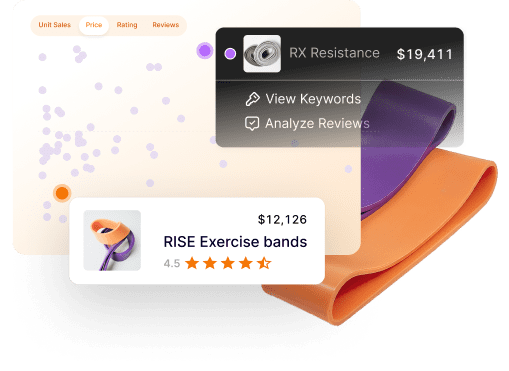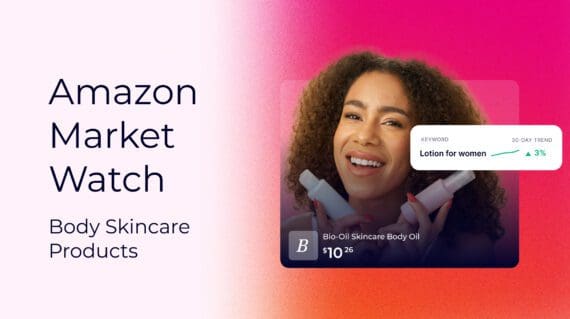Content
expand_moreSuccess when selling on Amazon hinges on understanding key metrics that drive profitability. Customer Lifetime Value (CLV) stands out as a critical indicator of long-term business health.
For Amazon sellers, comprehending and leveraging CLV can significantly enhance your business strategy, marketing efforts, and overall profitability.
This article dives into why you should know your CLV, how to calculate it, and strategies to increase your CLV on Amazon.
What is Customer Lifetime Value (CLV)?
Customer Lifetime Value (CLV) predicts the net profit attributed to the entire future relationship with a customer. Essentially, it estimates the total revenue you can expect from a single customer account throughout the entire duration of their relationship with your business.
Understanding CLV is crucial because it helps you assess the long-term value of customer relationships rather than focusing solely on short-term sales.
This metric allows businesses to make informed decisions about customer acquisition, retention strategies, and overall marketing investments.
Key components of CLV include:
- Average Purchase Value (APV): The average amount a customer spends in a single transaction.
- Average Purchase Frequency (APF): How often a customer makes a purchase.
- Customer Value (CV): The product of APV and APF, indicating a customer’s total revenue over a specific period.
- Average Customer Lifespan (ACL): The average duration a customer continues to purchase from your business.
Combining these elements, CLV provides a comprehensive view of a customer’s worth, enabling businesses to develop strategies that maximize profitability and growth.
Why you should know your customer lifetime value
Understanding CLV is crucial for any business, especially for those operating in Amazon’s competitive landscape. Here are key reasons why knowing your CLV is vital.
1. Strategic decision-making
- Resource allocation. CLV provides insight into where to allocate your resources most effectively. By understanding the long-term value of your customers, you can invest more in strategies that retain high-value customers and less in those that attract low-value ones.
- Customer retention. Focusing on customer retention becomes more straightforward when you know how much each customer is worth over their lifetime. This knowledge allows you to design retention strategies that keep your most valuable customers engaged and loyal.
2. Marketing efficiency
- Targeted campaigns. With a clear understanding of CLV, you can tailor your marketing campaigns to attract and retain high-value customers. This targeted approach ensures that your marketing efforts are more effective and yield a higher return on investment (ROI).
- Budget optimization. Knowing your CLV helps you determine the maximum budget for customer acquisition without compromising profitability. This ensures that you do not overspend on acquiring customers who will not generate sufficient revenue over their lifetime.
3. Profitability insights
- Revenue prediction. CLV enables accurate forecasting of future revenue streams based on existing customer behavior. This predictive capability is invaluable for long-term financial planning and stability.
- Cost management. By balancing customer acquisition costs (CAC) against the projected lifetime value of a customer, you can ensure sustainable growth. Understanding the relationship between CLV and CAC helps you decide how much to spend on acquiring new customers.
4. Business growth
- Scalability. Understanding CLV helps you identify and scale your business’s most profitable aspects. You can achieve scalable growth by focusing on strategies that maximize customer value.
- Competitive advantage. Businesses that effectively leverage CLV have a competitive edge. They can outspend competitors on customer acquisition and retention while maintaining profitability, allowing them to dominate their market.
5. Customer insights
- Customer behavior. CLV provides insights into customer purchasing behavior, preferences, and patterns. This information can be used to improve product offerings, customer service, and overall customer experience.
- Segmentation. Knowing the CLV of different customer segments allows you to tailor your approach to each segment. High-value segments can be given more personalized and attentive service, while strategies can be developed to increase the value of lower-value segments.
How to calculate customer lifetime value on Amazon
Calculating CLV involves a few essential steps, including determining average purchase value, purchase frequency, customer value, and customer lifespan. Here’s how you do it.
1. Determine Average Purchase Value (APV)
- Formula: APV= Total revenue/number of orders
- Example: If your total revenue is $50,000 and you had 1,000 orders, your APV is $50.
2. Determine Average Purchase Frequency (APF)
- Formula: APF= Number of purchases/number of customers
- Example: If you had 1,000 orders from 200 customers, your APF is 5.
3. Calculate Customer Value (CV)
- Formula: CV= APV x APF
- Example: If your APV is $50 and your APF is 5, your CV is $250.
4. Determine Average Customer Lifespan (ACL)
- Assessment: Estimate the average number of years a customer continues to purchase from your business. The typical lifespan of a customer is 1-3 years.
- Example: If customers, on average, purchase from you for 3 years, your ACL is 3. This exact information is tough to get from Amazon. You need every order from your Amazon selling history to get a precise figure.
5. Calculate Customer Lifetime Value (CLV)
- Formula: CLV=CV x ACL
- Example: If your CV is $250 and your ACL is 3 years, your CLV is $750.
How to increase Customer Lifetime Value on Amazon
Understanding your CLV can help you improve your overall Amazon business operations. Here are some ways sellers can increase their customer lifetime value on Amazon.
- Enhance customer experience. Provide prompt and efficient customer support to resolve issues quickly.
- Optimize listings. Improve your product listings with high-quality imagery, videos, and A+ Content to help increase your conversion rates.
- Refine advertising spend. Allocate your advertising budget more efficiently by focusing on campaigns and advertising types that attract high-CLV customers. Brands can use Jungle Scout Cobalt to run more profitable ad campaigns.
- Improve product quality. Listen to customer feedback and improve your best sellers to reduce return rates and boost customer loyalty.
- Expand your product line. Offer complementary products to your current line to encourage cross-selling and up-selling.
- Subscribe & Save. Sign your products up for the Subscribe & Save program to gain consistent repeat sales and increased customer loyalty. You can offer these customers discounts for subscribing, helping keep them subscribed for longer.
Access your Amazon market share with Cobalt.
Connect with our sales team to find out how Cobalt helps you achieve unbelievable results on Amazon.
Do you know your Customer Lifetime Value?
Customer Lifetime Value is more than just a metric; it’s a strategic tool that drives business success.
By understanding and leveraging CLV, you can make informed decisions that enhance customer retention, improve marketing efficiency, and drive long-term profitability.
For Amazon sellers, this means not just surviving but thriving in a highly competitive marketplace. Regularly analyzing and acting on CLV data ensures that your business remains agile, customer-focused, and positioned for sustainable growth.
Brian Connolly is an Amazon seller, ecommerce expert, and writer for Jungle Scout. He lives in the New Jersey Shore area with his wife and cat. When he isn’t writing advice online for aspiring and experienced Amazon sellers for Jungle Scout, he spends his free time boating, fishing, and selling boating-themed items on his Amazon business.










